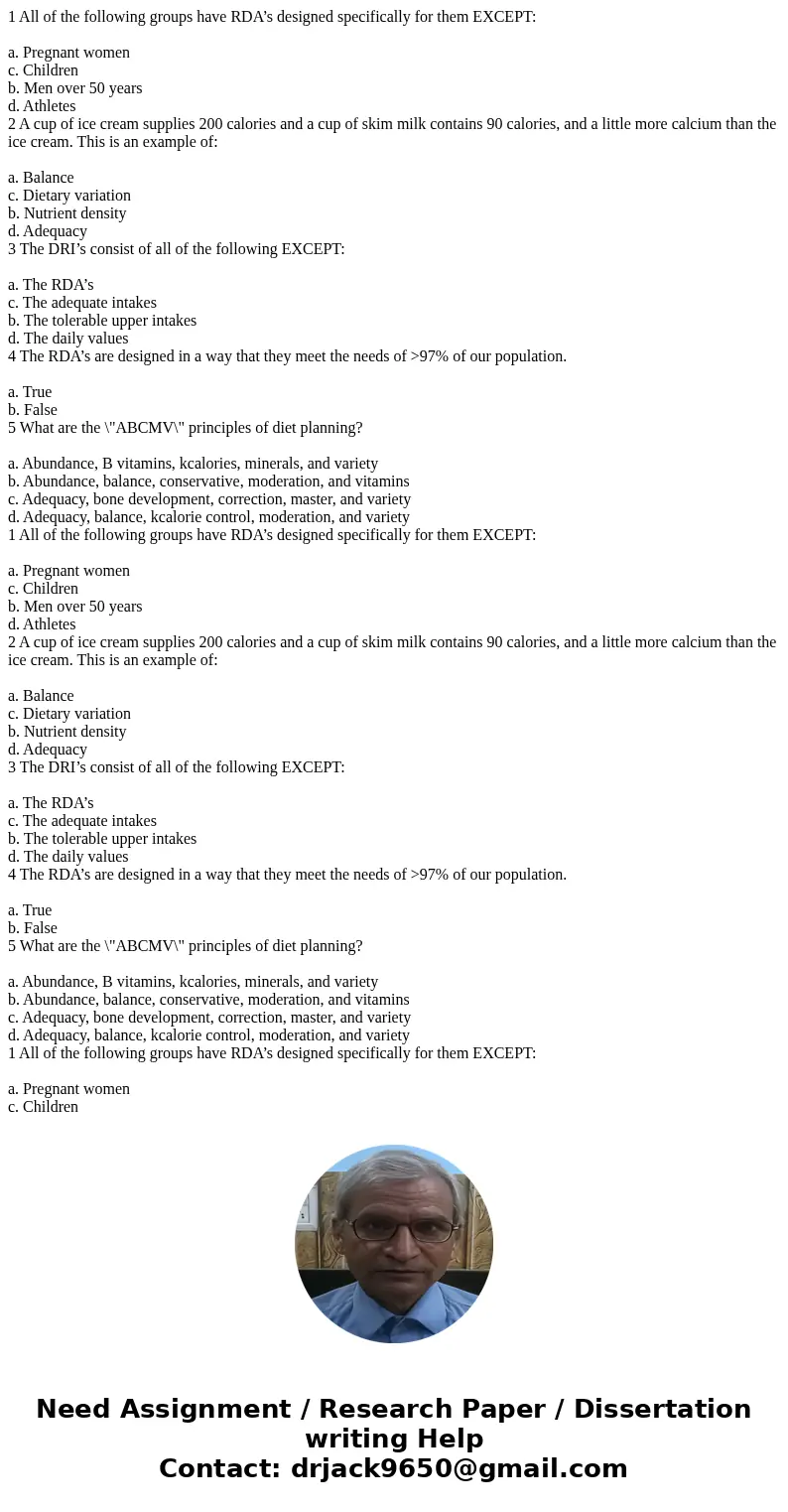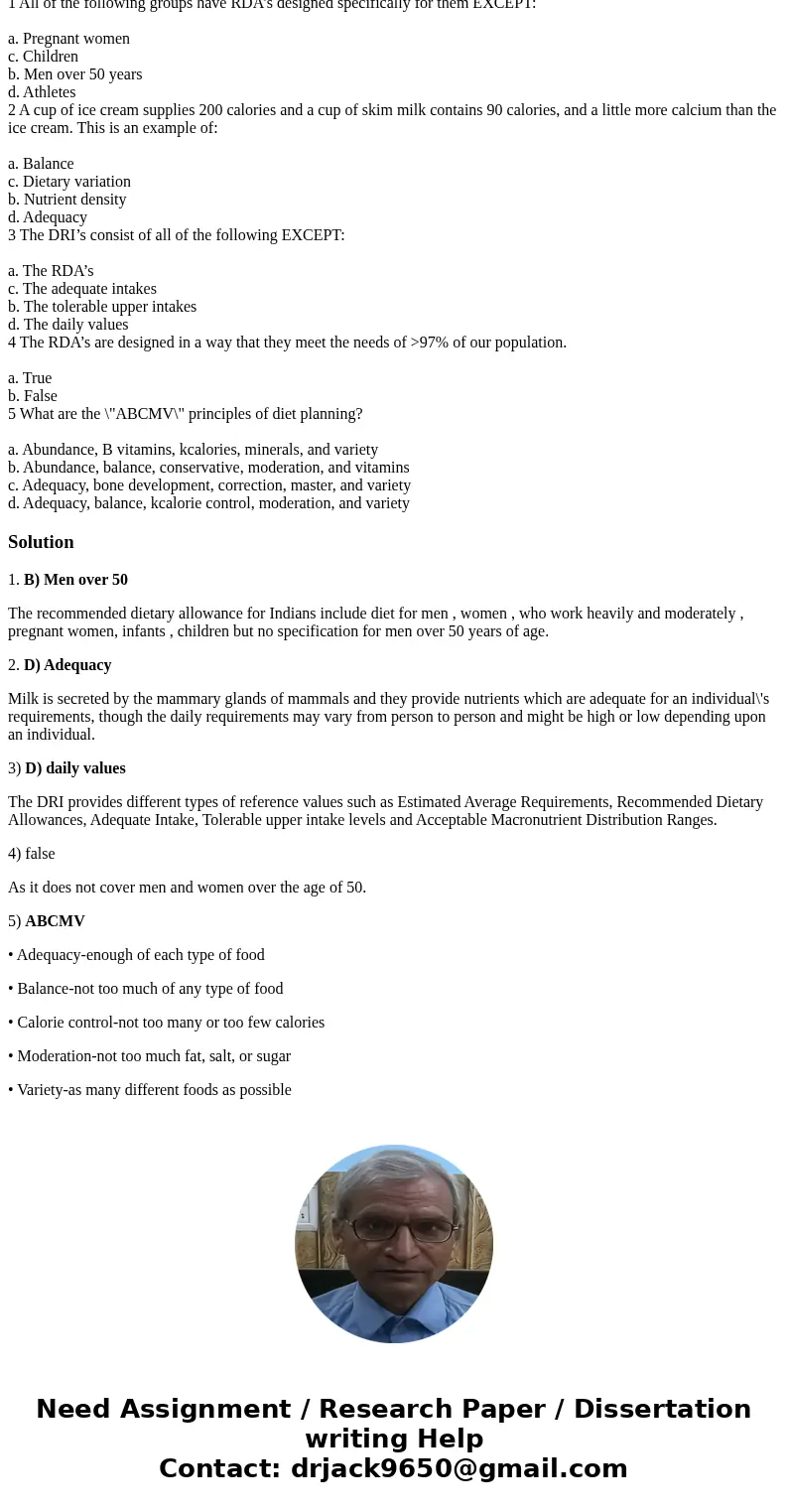1 All of the following groups have RDA’s designed specifically for them EXCEPT:
a. Pregnant women
c. Children
b. Men over 50 years
d. Athletes
2 A cup of ice cream supplies 200 calories and a cup of skim milk contains 90 calories, and a little more calcium than the ice cream. This is an example of:
a. Balance
c. Dietary variation
b. Nutrient density
d. Adequacy
3 The DRI’s consist of all of the following EXCEPT:
a. The RDA’s
c. The adequate intakes
b. The tolerable upper intakes
d. The daily values
4 The RDA’s are designed in a way that they meet the needs of >97% of our population.
a. True
b. False
5 What are the \"ABCMV\" principles of diet planning?
a. Abundance, B vitamins, kcalories, minerals, and variety
b. Abundance, balance, conservative, moderation, and vitamins
c. Adequacy, bone development, correction, master, and variety
d. Adequacy, balance, kcalorie control, moderation, and variety
1 All of the following groups have RDA’s designed specifically for them EXCEPT:
a. Pregnant women
c. Children
b. Men over 50 years
d. Athletes
2 A cup of ice cream supplies 200 calories and a cup of skim milk contains 90 calories, and a little more calcium than the ice cream. This is an example of:
a. Balance
c. Dietary variation
b. Nutrient density
d. Adequacy
3 The DRI’s consist of all of the following EXCEPT:
a. The RDA’s
c. The adequate intakes
b. The tolerable upper intakes
d. The daily values
4 The RDA’s are designed in a way that they meet the needs of >97% of our population.
a. True
b. False
5 What are the \"ABCMV\" principles of diet planning?
a. Abundance, B vitamins, kcalories, minerals, and variety
b. Abundance, balance, conservative, moderation, and vitamins
c. Adequacy, bone development, correction, master, and variety
d. Adequacy, balance, kcalorie control, moderation, and variety
1 All of the following groups have RDA’s designed specifically for them EXCEPT:
a. Pregnant women
c. Children
b. Men over 50 years
d. Athletes
2 A cup of ice cream supplies 200 calories and a cup of skim milk contains 90 calories, and a little more calcium than the ice cream. This is an example of:
a. Balance
c. Dietary variation
b. Nutrient density
d. Adequacy
3 The DRI’s consist of all of the following EXCEPT:
a. The RDA’s
c. The adequate intakes
b. The tolerable upper intakes
d. The daily values
4 The RDA’s are designed in a way that they meet the needs of >97% of our population.
a. True
b. False
5 What are the \"ABCMV\" principles of diet planning?
a. Abundance, B vitamins, kcalories, minerals, and variety
b. Abundance, balance, conservative, moderation, and vitamins
c. Adequacy, bone development, correction, master, and variety
d. Adequacy, balance, kcalorie control, moderation, and variety
1. B) Men over 50
The recommended dietary allowance for Indians include diet for men , women , who work heavily and moderately , pregnant women, infants , children but no specification for men over 50 years of age.
2. D) Adequacy
Milk is secreted by the mammary glands of mammals and they provide nutrients which are adequate for an individual\'s requirements, though the daily requirements may vary from person to person and might be high or low depending upon an individual.
3) D) daily values
The DRI provides different types of reference values such as Estimated Average Requirements, Recommended Dietary Allowances, Adequate Intake, Tolerable upper intake levels and Acceptable Macronutrient Distribution Ranges.
4) false
As it does not cover men and women over the age of 50.
5) ABCMV
• Adequacy-enough of each type of food
• Balance-not too much of any type of food
• Calorie control-not too many or too few calories
• Moderation-not too much fat, salt, or sugar
• Variety-as many different foods as possible


 Homework Sourse
Homework Sourse